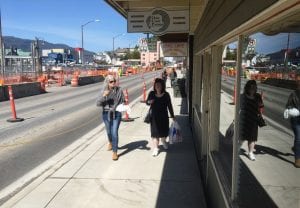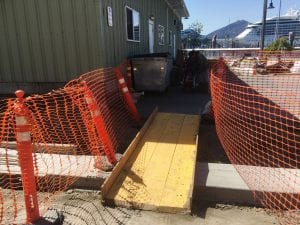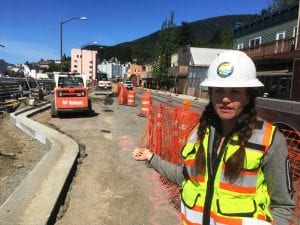
Road construction crews work on sidewalk reconstruction on Stedman Street, part of a multi-phase state Department of Transportation project to overhaul Ketchikan’s downtown core. (KRBD photo by Leila Kheiry)
Cruise season in Ketchikan unfortunately coincides with road construction season. This year will especially test the patience of local drivers, with major upgrades to one of downtown Ketchikan’s busiest sections for cars and pedestrians.
Stedman Street in Ketchikan is lined with restaurants, hotels and shops. The street also connects to the city’s famous Creek Street red-light district and busy Thomas Basin boat harbor.
It’s also the main road headed south to and from Saxman, Mountain Point Boat Launch, Herring Cove and other popular destinations. So, large buses, trucks pulling boats and people just trying to get to work drive through all the time.
Now let’s add in torn-up sidewalks, construction machinery, no parking and a narrowed roadway.
“This is a project where there was a lot of work during the design phase, to deal with the amount of pedestrian traffic, figure out how to maintain access to businesses, have less impact to businesses in other ways, and then also to deal with moving vehicles through this core, central road in Ketchikan,” said Aurah Landau, DOT spokeswoman. “I just saw a duck boat go by, there’s lots of personal vehicles and other tour buses. It’s a very complex traffic situation.”

Pedestrians walk on the newly rebuilt sidewalk on Stedman Street. DOT is reconstructing sidewalks and roads throughout Ketchikan’s downtown core, starting with Stedman. (KRBD photo by Leila Kheiry)
Landau was one of the department’s officials in town recently to take a look at current construction work.
Garrett Paul is DOT construction project manager. He said the whole reconstruction project involves Ketchikan’s main road from the downtown tunnel to Deermount Street.
They started planning the project about five years ago.
“When you’re approaching a downtown project, you really have to think of the impacts that has on the community,” he said.
A big part of reducing impacts is to do the project in phases. The current phase is a shortish section from Ketchikan Creek to Deermount.
They started with sidewalks. One side of the street was pretty much done by the time cruise season started, and now the contractor, Secon, is working on the harbor-side.
“And as soon as the sidewalk work is done, we’re actually going to night work,” he said. “We’re going to a 3 p.m. to 1 a.m. schedule. That is generally after the boats leave, and that way we can open up more and do more in the roadway.”

A ramp provides access to Ketchikan’s Salvation Army and Thomas Basin Boat Harbor while crews work on sidewalk reconstruction on Stedman Street. The harbor-side sidewalks should be done in early June. (KRBD photo by Leila Kheiry)
That means paving, which can get noisy. DOT negotiated the time frame with local hotels so guests could get some sleep.
Project Engineer Mandi Pelhan said all sidewalk work for this phase should be done in early June. The sidewalks are 8-feet wide. That’s wider than previously, and brings them up to current standards.
That means a narrower roadway. But, Paul said there still will be street parking like before. A handful of spaces had to be sacrificed, though, for pedestrian bump-outs.
“Which are, basically instead of pedestrians crossing behind the parked vehicles, they will be out next to the road and you’ll be able to see them,” he said. “We have four bump-outs on this segment. One is being constructed over there right now. I think they ended up taking four parking spots away.”
That’s four fewer spaces for the entire length of Stedman Street.
Landau said they’ve been working hard to keep the public as informed as possible about the project.
“The public information piece of this is challenging because we have such different needs,” she said.

Project Engineer Mandi Pelhan talks about the progress made on sidewalk reconstruction on Stedman Street. She says the sidewalks in the first phase of the project should be done in early June. (KRBD photo by Leila Kheiry)
They worked directly with businesses and residents affected, and put out regular notices through local media and social media.
Landau said they can’t really do that for cruise visitors, though, so they had to make sure flagging, ropes and barriers clearly mark where it’s safe to walk.
Pelhan said she’s happy with Secon’s pedestrian-management efforts.
“I mean, yesterday was crazy. We had – I don’t remember how many ships– but big tour groups and a lot of foreigners and they would have their flags, herds of them would follow,” she said. “It was nice to have these ropes here because they stayed on the sidewalk. We didn’t have anyone jumping out taking pictures. It was good to see that good flow of pedestrian traffic.”
The work is going smoothly so far, although, Pelhan said there were some last-minute adjustments that had to be made once crews started pulling up pavement.
“The history of these building is old cannery buildings that got floated in here sometimes, 1920 or something, and got set up on pilings,” she said. “Well, there are still the old pilings. Then when we pulled the sidewalk out, we were like, ‘Ooh. This isn’t good.’ So we had to accommodate for those kinds of design changes.”
Pretty typical for any reconstruction project: You never know what’s under the surface until you start digging.
The Alaska Department of Transportation has a lot of projects under way or in the planning stages for Ketchikan. More road patching is planned to fill potholes, for example, and Landau said between now and 2020, DOT has about $200 million worth of projects slated for Ketchikan.
We’ll have another story later this week about DOT’s multi-year reconstruction project on Upper Water Street.





